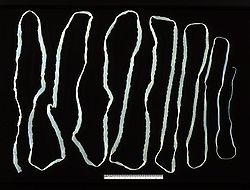Classes
Cestoda... tapeworms: this class is made up entirely of parasitic worms. They are specialized to be parasites. Most tapeworms require two hosts; an intermediate host, which is usually an invertebrate, and a primary host, which is usually a vertebrate. Some species of tapeworms can infect humans but in most cases they do not cause serious health problems and are easy to get rid of. Tapeworms lack a digestive system so, to compensate, they simply absorb nutrients from food eaten by their hosts through their cell wall. Their bodies also have "sets" called proglottids that are specifically for reproduction. Once a tapeworm is mature, they release eggs into the poop of their host. Source: http://www.earthlife.net/inverts/cestoda.html
Monogenea... flukes: most worms of the monogenea class are ectoparasites. Monogeneans have a series of attachment organs that are suckers, clamps, hooks, and spines. Monogeneans, like cestodes, usually have two hosts. A primary host is usually a cephalopod, fish, reptile, or a whale. The intermediate host is a smaller organism that the primary host eats. Source: http://www.earthlife.net/inverts/monogenea.html
Trematoda... flukes: like the class cestoda, this class is composed of nothing but parasites. Which is a sharp contrast to the class turbellaria, which are all free-living worms. The inside of a trematoda is mostly reproductive parts. Trematodes are built for making offspring and most are hermaphrodites that are capable of self-fertilization. Trematodes have two hosts. The intermediate hosts are usually either fish or snails and the primary hosts are vertebrates. Source: http://www.infoplease.com/encyclopedia/science/platyhelminthes-class-trematoda.html
Turbellaria: this class is unique among the other three because most turbellarians are free-living and carnivorous. They are hermaphrodites, but can sexually reproduce. If two turbellarians mate, they inseminate each other. The diet of a turbellarian is sometimes algae, bits of fish, crustaceans, and worms. Source: http://mdc.mo.gov/discover-nature/field-guide/turbellarians-planarians-free-living-flatworms
Monogenea... flukes: most worms of the monogenea class are ectoparasites. Monogeneans have a series of attachment organs that are suckers, clamps, hooks, and spines. Monogeneans, like cestodes, usually have two hosts. A primary host is usually a cephalopod, fish, reptile, or a whale. The intermediate host is a smaller organism that the primary host eats. Source: http://www.earthlife.net/inverts/monogenea.html
Trematoda... flukes: like the class cestoda, this class is composed of nothing but parasites. Which is a sharp contrast to the class turbellaria, which are all free-living worms. The inside of a trematoda is mostly reproductive parts. Trematodes are built for making offspring and most are hermaphrodites that are capable of self-fertilization. Trematodes have two hosts. The intermediate hosts are usually either fish or snails and the primary hosts are vertebrates. Source: http://www.infoplease.com/encyclopedia/science/platyhelminthes-class-trematoda.html
Turbellaria: this class is unique among the other three because most turbellarians are free-living and carnivorous. They are hermaphrodites, but can sexually reproduce. If two turbellarians mate, they inseminate each other. The diet of a turbellarian is sometimes algae, bits of fish, crustaceans, and worms. Source: http://mdc.mo.gov/discover-nature/field-guide/turbellarians-planarians-free-living-flatworms
Digestion
Some flatworms have a digestive tract that features a gut that is used for digestion. Food enters and exits through their mouth. Other worms, like tapeworms, do not have a digestive system. Instead, they absorb nutrients through their wall.
Representative Organism: Taenia saginata

- Scientific name: Taenia saginata
- Common name: Beef tapeworm
- Class: cestoda
- Found in raw or under-cooked beef, hence the name "beef tapeworm"

- The beef tapeworm is found worldwide, mostly in areas where raw beef is eaten
- Common in Eastern Europe, Russia, eastern Africa, and Latin America
- Rare in the U.S.
- The beef tapeworm tends to cause more symptoms than Taenia solium or Taenia asiatica, but doesn't lead to cysticercosis
- Symptoms include: weight loss, abdominal pain, upset stomach, and appetite loss
Source: http://www.cdc.gov/parasites/taeniasis/gen_info/faqs.html
